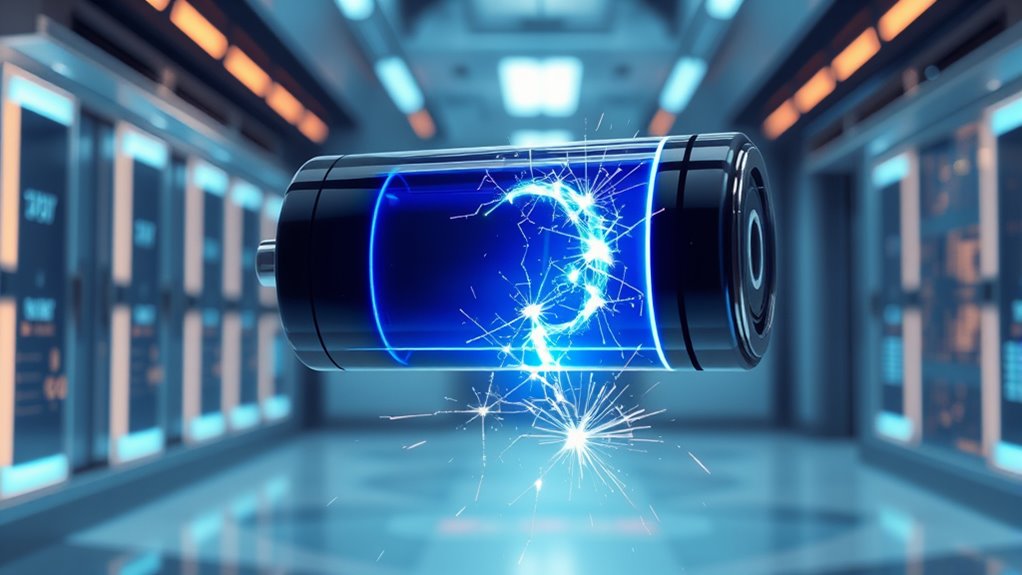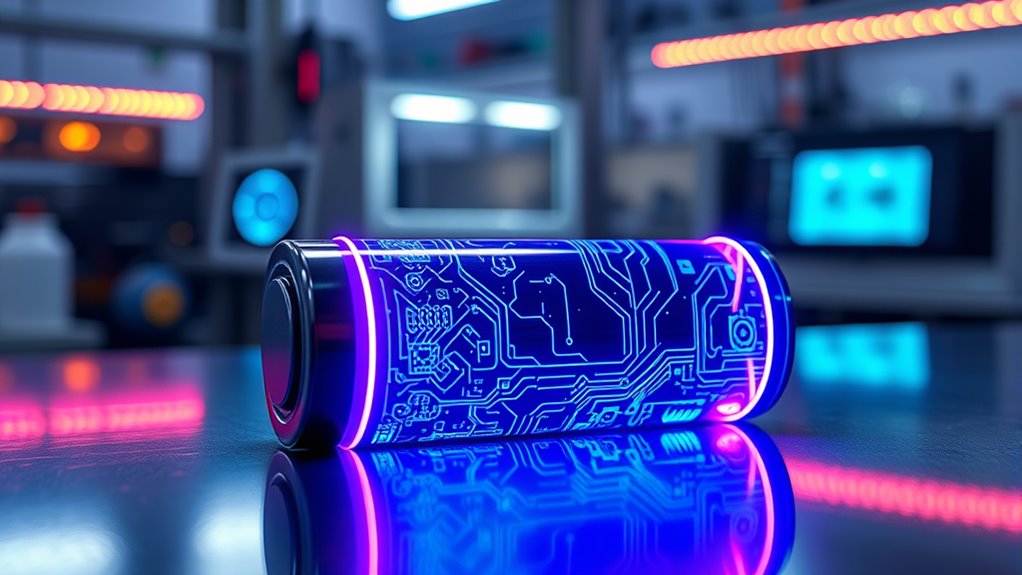Quantum batteries are an exciting innovation capable of charging in seconds by using quantum effects such as superposition and entanglement. These technologies manipulate quantum states to store and transfer energy more efficiently than traditional batteries. They avoid issues like overheating and chemical wear, offering faster and more sustainable power solutions. If you want to discover how these devices could transform energy storage, continue exploring to learn more about their potential and future applications.
Key Takeaways
- Quantum batteries utilize quantum superposition and entanglement to enable ultra-fast charging, potentially within seconds.
- Researchers have developed theoretical models demonstrating near-instant charging capabilities through quantum state manipulation.
- Experimental prototypes are progressing, aiming to achieve rapid energy transfer without traditional chemical processes.
- Quantum coherence maintained by electromagnetic cavities allows for quick and efficient energy storage and release.
- Advances in many-body quantum systems suggest practical quantum batteries could soon realize seconds-scale charging times.

Quantum batteries represent a groundbreaking approach to energy storage that leverages the principles of quantum mechanics rather than traditional chemical reactions. Instead of relying on chemical processes, these batteries store and release energy through quantum states of particles like electrons or atoms. By exploiting phenomena such as superposition and entanglement, quantum batteries can potentially achieve rapid charging and discharging cycles. Unlike conventional batteries, which depend on ion movement within electrolytes, quantum batteries manipulate microscopic quantum effects, making their operation fundamentally different and promising faster, more efficient energy transfer.
Quantum batteries use quantum states instead of chemical reactions for faster, more efficient energy storage.
You should understand that the core principle behind quantum batteries involves encoding energy into the quantum states of particles. Superposition allows particles to occupy multiple states simultaneously, effectively enabling parallel energy storage. Meanwhile, entanglement links particles so that their states are correlated, allowing collective behavior that enhances charging speed. When many particles are entangled, the system can exhibit superabsorption, a phenomenon where energy transfer accelerates considerably. This collective effect means larger quantum batteries could charge much faster than their classical counterparts, potentially reducing charging times to seconds or less.
Charging and discharging in quantum batteries occur through precise manipulation of quantum states, rather than ion flow. Researchers achieve this by controlling the interactions between particles, often using small quantum systems like single atoms coupled to electromagnetic cavities. These cavities help maintain quantum coherence, preventing decoherence effects that could degrade performance. Models exploring coupled quantum harmonic oscillators with complex interactions have demonstrated theoretical advantages, and cutting-edge frameworks like the Sachdev–Ye–Kitaev (SYK) model explore many-body systems to maximize speed and efficiency.
You’ll find that quantum batteries offer several advantages over traditional energy storage systems. They can avoid issues like overheating, chemical degradation, and limited charge-discharge cycles because they do not rely on chemical reactions. This approach promises higher energy densities, faster charging times, and improved efficiency. Moreover, since quantum batteries don’t depend on rare or hazardous materials, they could be more sustainable. Fine control at the quantum level opens the door to more stable, longer-lasting energy devices, which could integrate seamlessly with emerging quantum technologies in computing and sensing.
Although the concept has only been around for about 10-15 years, research is rapidly progressing. Experimental prototypes are still mostly in the lab stage, but recent advancements show that realizing practical quantum batteries charging in seconds is becoming increasingly feasible. As scientists continue to refine models and develop experimental setups, this technology could revolutionize how we store and use energy, making instant charging a real possibility in the near future.
Frequently Asked Questions
Can Quantum Batteries Be Integrated Into Existing Electronic Devices?
You wonder if quantum batteries can fit into your current devices. The good news is, they can be integrated by adding conductive layers that convert photon energy into usable power. While some redesigns are needed due to different materials and architectures, ongoing advancements make this feasible within a few years. This integration could lead to faster charging, smaller devices, and more efficient energy use, transforming how you power your electronics.
What Are the Safety Implications of Rapid Charging Quantum Batteries?
You might be surprised to learn that rapid charging can raise battery temperatures up to 99°C, risking overheating, mechanical damage, or even thermal runaway. You need to consider gas release, pressure buildup, and potential cell rupture, which could cause fires or explosions. That’s why ongoing safety testing, advanced materials, and thermal management are vital to guarantee your quantum battery remains safe during fast charging, minimizing these risks effectively.
How Long Do Quantum Batteries Maintain Their Energy Capacity?
You’re curious about how long quantum batteries keep their energy. Currently, they can store energy for about 40.3 microseconds, a huge improvement from nanoseconds. This extended retention, achieved through advanced quantum states, moves them closer to practical use in electronics and solar cells. However, they still don’t last as long as traditional batteries. Ongoing research aims to increase this duration further, making quantum batteries more viable for real-world applications.
Are Quantum Batteries Commercially Available Today?
You’re asking if quantum batteries are available today. Right now, they’re like seedlings just beginning to sprout—mostly in labs and pilot projects. Industry leaders aim for commercial products by 2025, but widespread availability is still a few years away. While promising technologies like solid-state and quantum dot batteries are advancing rapidly, full-scale market deployment hasn’t yet arrived. So, you can’t buy them off the shelf just yet.
What Materials Are Used to Develop Quantum Batteries?
You’re curious about the materials used to develop quantum batteries. These batteries rely on materials supporting quantum states like superposition and entanglement, such as specialized nanomaterials that enable superabsorption. Photonic energy storage components, which capture energy from photons, are key. Researchers also explore advanced chemical compounds, including lithium-based molecules, rare metals, and innovative alloys, aiming for higher efficiency, sustainability, and faster charging capabilities in future battery technologies.
Conclusion
Quantum batteries charge in seconds, revolutionizing how you power your devices. They promise faster, more efficient, and more reliable energy storage. With quick charging, better performance, and endless potential, they’re ready to change your daily life. Embrace the future, harness the power of quantum physics, and experience the convenience of batteries that charge in seconds. Because when technology advances, you advance — faster, smarter, and more connected.










